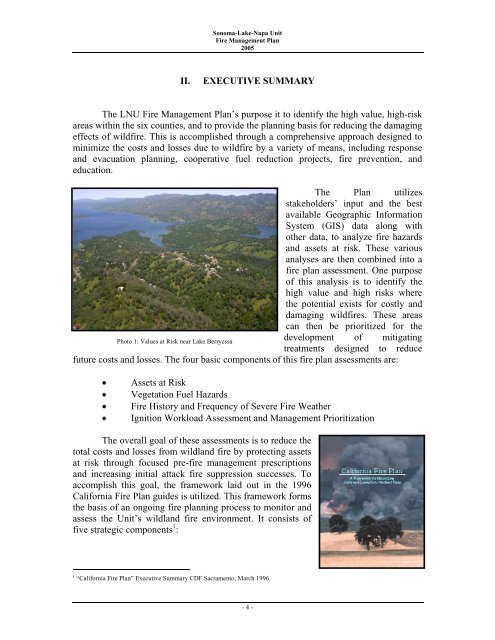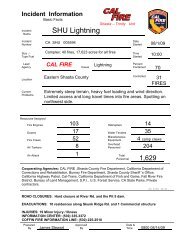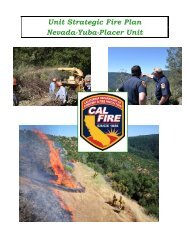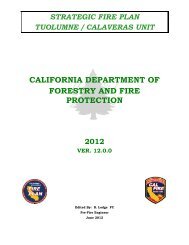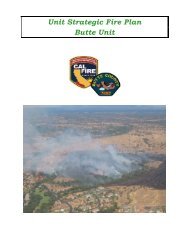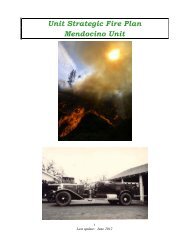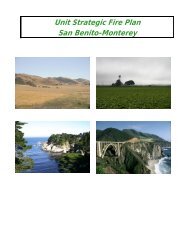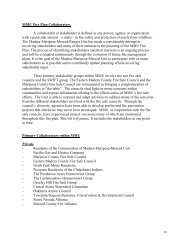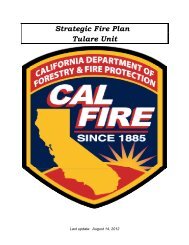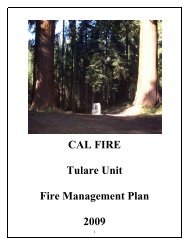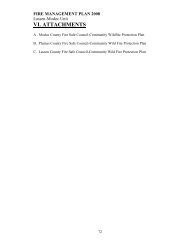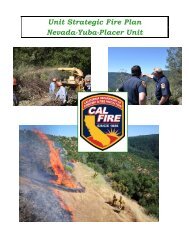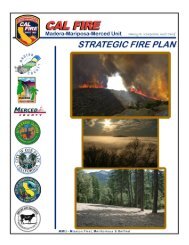Sonoma-Lake-Napa Fire Plan - Board of Forestry and Fire ...
Sonoma-Lake-Napa Fire Plan - Board of Forestry and Fire ...
Sonoma-Lake-Napa Fire Plan - Board of Forestry and Fire ...
You also want an ePaper? Increase the reach of your titles
YUMPU automatically turns print PDFs into web optimized ePapers that Google loves.
<strong>Sonoma</strong>-<strong>Lake</strong>-<strong>Napa</strong> Unit<br />
<strong>Fire</strong> Management <strong>Plan</strong><br />
2005<br />
II. EXECUTIVE SUMMARY<br />
The LNU <strong>Fire</strong> Management <strong>Plan</strong>’s purpose it to identify the high value, high-risk<br />
areas within the six counties, <strong>and</strong> to provide the planning basis for reducing the damaging<br />
effects <strong>of</strong> wildfire. This is accomplished through a comprehensive approach designed to<br />
minimize the costs <strong>and</strong> losses due to wildfire by a variety <strong>of</strong> means, including response<br />
<strong>and</strong> evacuation planning, cooperative fuel reduction projects, fire prevention, <strong>and</strong><br />
education.<br />
The <strong>Plan</strong> utilizes<br />
stakeholders’ input <strong>and</strong> the best<br />
available Geographic Information<br />
System (GIS) data along with<br />
other data, to analyze fire hazards<br />
<strong>and</strong> assets at risk. These various<br />
analyses are then combined into a<br />
fire plan assessment. One purpose<br />
<strong>of</strong> this analysis is to identify the<br />
high value <strong>and</strong> high risks where<br />
the potential exists for costly <strong>and</strong><br />
damaging wildfires. These areas<br />
can then be prioritized for the<br />
Photo 1: Values at Risk near <strong>Lake</strong> Berryessa<br />
development <strong>of</strong> mitigating<br />
treatments designed to reduce<br />
future costs <strong>and</strong> losses. The four basic components <strong>of</strong> this fire plan assessments are:<br />
• Assets at Risk<br />
• Vegetation Fuel Hazards<br />
• <strong>Fire</strong> History <strong>and</strong> Frequency <strong>of</strong> Severe <strong>Fire</strong> Weather<br />
• Ignition Workload Assessment <strong>and</strong> Management Prioritization<br />
The overall goal <strong>of</strong> these assessments is to reduce the<br />
total costs <strong>and</strong> losses from wildl<strong>and</strong> fire by protecting assets<br />
at risk through focused pre-fire management prescriptions<br />
<strong>and</strong> increasing initial attack fire suppression successes. To<br />
accomplish this goal, the framework laid out in the 1996<br />
California <strong>Fire</strong> <strong>Plan</strong> guides is utilized. This framework forms<br />
the basis <strong>of</strong> an ongoing fire planning process to monitor <strong>and</strong><br />
assess the Unit’s wildl<strong>and</strong> fire environment. It consists <strong>of</strong><br />
five strategic components 1 :<br />
1 “California <strong>Fire</strong> <strong>Plan</strong>” Executive Summary CDF Sacramento, March 1996.<br />
- 4 -


